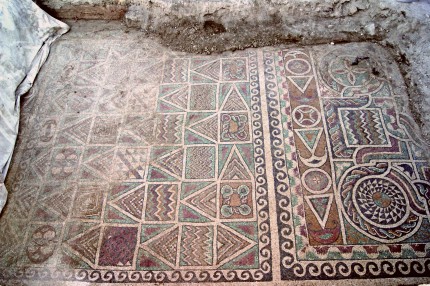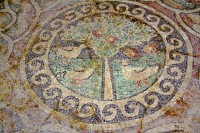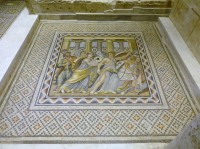Archaeologists excavating the village of Yavru in Turkey’s Black Sea Amasya Province have discovered a mosaic with an unusual geometric pattern reminiscent of motifs found on kilim rugs.

Çorum-based Hitit University Black Sea Archaeology Research and Practice Center Deputy Director Associate Professor Esra Keskin said the mosaics that had been found in a palace-like place had a different design when compared to the other artifacts in the same era.
Keskin said the mosaics were surrounded by curbstones. “The eye shapes on the kilim designs of the mosaics still retain their secrets. The mosaics cover an area of 30 square meters and the kilim-like motifs on it show that they might have been the coat of arms of a military unit in the Roman era.”
I have no idea why the triangles, diamonds, chevrons and zig-zags in the mosaic would be the “coat of arms” of a Roman legion. As far as I know, Roman standards used animals, deities, mythological figures as emblems, not abstract geometric shapes. I suspect there’s some weird translation issue going on here.
 Intriguing geometric mosaics aren’t the only kind that have been unearthed at this site. Birds, fruit, ropes, flowers and people also decorate the floors of the palatial villa, and they’re all extremely high quality work. The mosaics haven’t been dated yet, but Professor Keskin thinks they have some stylistic similarity to the mosaics found in Zeugma.
Intriguing geometric mosaics aren’t the only kind that have been unearthed at this site. Birds, fruit, ropes, flowers and people also decorate the floors of the palatial villa, and they’re all extremely high quality work. The mosaics haven’t been dated yet, but Professor Keskin thinks they have some stylistic similarity to the mosaics found in Zeugma.
Zeugma was a Hellenistic city founded by Seleucus I Nicator, one of Alexander the Great’s generals, in south central Turkey. It’s famous for the vast number and exceptional quality of mosaics recovered from the remains of Roman villas and baths before the ruins disappeared underneath  the floodwaters from dam construction in 2000. The Zeugma Mosaic Museum has the largest square footage of mosaics in the world, housing an astonishing 24,000 square feet of ancient Roman mosaics. The odds are slim that the Yavru finds will ever come anywhere close to Zeugma. At this point, comparing a place to Zeugma has become shorthand for cool mosaic finds of any kind in Turkey. (See this mosaic-heavy site in Izmir, on the Aegean coast of western Turkey, for another example.)
the floodwaters from dam construction in 2000. The Zeugma Mosaic Museum has the largest square footage of mosaics in the world, housing an astonishing 24,000 square feet of ancient Roman mosaics. The odds are slim that the Yavru finds will ever come anywhere close to Zeugma. At this point, comparing a place to Zeugma has become shorthand for cool mosaic finds of any kind in Turkey. (See this mosaic-heavy site in Izmir, on the Aegean coast of western Turkey, for another example.)
The region’s capital Amasya has in the past few years begun to focus on its rich history to attract tourism, so it’s no wonder they’d like to be thought of Zeugma 2: The Zeugmaning. Many of its traditional Ottoman houses have been restored and become part of the burgeoning hospitality industry as bars, restaurants and hotels. Behind them loom cliffs where the kings of Pontus (Amasya, known as Amaseia in antiquity, was the capital of Pontus) carved their tombs. Already hundreds of thousands of tourists, most of them Turkish but the number of international visitors is increasing geometrically each year, visit Amasya each year. A trove of uniquely beautiful Roman mosaics is sure to draw even more crowds.